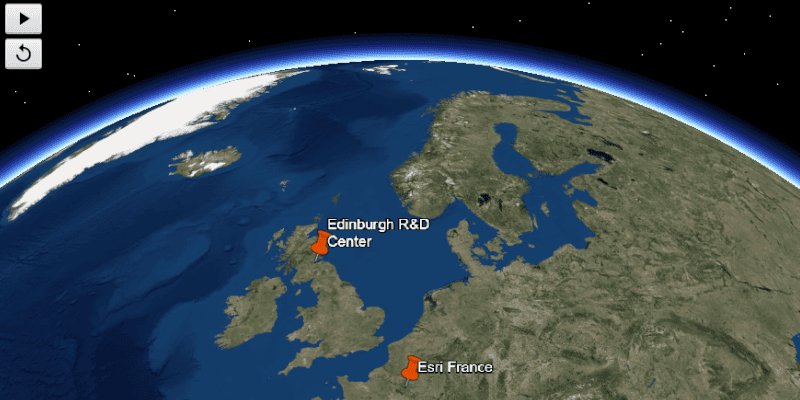Play tours in KML files.

Use case
KML, the file format used by Google Earth, supports creating tours, which can control the viewpoint of the scene, hide and show content, and play audio. Tours allow you to easily share tours of geographic locations, which can be augmented with rich multimedia. ArcGIS Maps SDK for Java allows you to consume these tours using a simple API.
How to use the sample
The sample will load the KMZ file from ArcGIS Online. Click the play button to start the tour. The narration audio will start and then the viewpoint will animate. Press the button again to pause the tour. To restart the tour, hit the refresh button and then the play button.
How it works
- Create a
KmlDatasetwith the path to a local KML file with a KML tour. - Create and load a
KmlLayerwith the dataset. - When the layer has loaded, search its
KmlNodes by recursing throughkmlLayer.getRootNodes()to find aKmlTournode. - Create a
KmlTourControllerand set the tour withkmlTourController.setTour(kmlTour). - Use
kmltourController.play(),kmltourController.pause(), andkmltourController.reset()to control the tour.
Relevant API
- KmlTour
- KmlTourController
About the data
This sample uses a custom tour created by the ArcGIS Maps SDKs for Native Apps samples team. When you play the tour, you'll see a narrated journey through some of Esri's offices.
Additional information
See Touring in KML in Keyhole Markup Language for more information.
Tags
animation, interactive, KML, narration, pause, play, story, tour
Sample Code
/*
* Copyright 2019 Esri.
*
* Licensed under the Apache License, Version 2.0 (the "License"); you may not
* use this file except in compliance with the License. You may obtain a copy of
* the License at
*
* http://www.apache.org/licenses/LICENSE-2.0
*
* Unless required by applicable law or agreed to in writing, software
* distributed under the License is distributed on an "AS IS" BASIS, WITHOUT
* WARRANTIES OR CONDITIONS OF ANY KIND, either express or implied. See the
* License for the specific language governing permissions and limitations under
* the License.
*/
package com.esri.samples.play_a_kml_tour;
import java.io.File;
import java.util.List;
import javafx.application.Application;
import javafx.geometry.Insets;
import javafx.geometry.Pos;
import javafx.scene.Scene;
import javafx.scene.control.Alert;
import javafx.scene.control.Button;
import javafx.scene.image.Image;
import javafx.scene.image.ImageView;
import javafx.scene.layout.StackPane;
import javafx.scene.layout.VBox;
import javafx.stage.Stage;
import com.esri.arcgisruntime.ArcGISRuntimeEnvironment;
import com.esri.arcgisruntime.layers.KmlLayer;
import com.esri.arcgisruntime.loadable.LoadStatus;
import com.esri.arcgisruntime.mapping.ArcGISScene;
import com.esri.arcgisruntime.mapping.ArcGISTiledElevationSource;
import com.esri.arcgisruntime.mapping.BasemapStyle;
import com.esri.arcgisruntime.mapping.Surface;
import com.esri.arcgisruntime.mapping.view.SceneView;
import com.esri.arcgisruntime.ogc.kml.KmlContainer;
import com.esri.arcgisruntime.ogc.kml.KmlDataset;
import com.esri.arcgisruntime.ogc.kml.KmlNode;
import com.esri.arcgisruntime.ogc.kml.KmlTour;
import com.esri.arcgisruntime.ogc.kml.KmlTourController;
import com.esri.arcgisruntime.ogc.kml.KmlTourStatus;
public class PlayAKMLTourSample extends Application {
private KmlTourController kmlTourController;
private SceneView sceneView;
@Override
public void start(Stage stage) {
try {
// create stack pane and application scene
StackPane stackPane = new StackPane();
Scene fxScene = new Scene(stackPane);
// set up the stage
stage.setTitle("Play a KML Tour Sample");
stage.setWidth(800);
stage.setHeight(700);
stage.setScene(fxScene);
stage.show();
// authentication with an API key or named user is required to access basemaps and other location services
String yourAPIKey = System.getProperty("apiKey");
ArcGISRuntimeEnvironment.setApiKey(yourAPIKey);
// create a scene and show it in a scene view
sceneView = new SceneView();
ArcGISScene scene = new ArcGISScene(BasemapStyle.ARCGIS_IMAGERY);
sceneView.setArcGISScene(scene);
// add elevation data
Surface surface = new Surface();
surface.getElevationSources().add(new ArcGISTiledElevationSource("https://elevation3d.arcgis.com/arcgis/rest/services/WorldElevation3D/Terrain3D/ImageServer"));
scene.setBaseSurface(surface);
// create play/pause button
final ImageView playIcon = new ImageView(new Image(PlayAKMLTourSample.class.getResourceAsStream(
"/play.png")));
final ImageView pauseIcon = new ImageView(new Image(PlayAKMLTourSample.class.getResourceAsStream(
"/pause.png")));
Button playPauseButton = new Button();
playPauseButton.setGraphic(playIcon);
playPauseButton.setDisable(true);
playPauseButton.setOnAction(e -> {
if (kmlTourController.getTour().getTourStatus() == KmlTourStatus.PLAYING) {
kmlTourController.pause();
} else {
kmlTourController.play();
}
});
// create replay button
final ImageView replayIcon = new ImageView(new Image(PlayAKMLTourSample.class.getResourceAsStream(
"/replay.png")));
Button replayButton = new Button();
replayButton.setGraphic(replayIcon);
replayButton.setDisable(true);
replayButton.setOnAction(e -> {
kmlTourController.reset();
playPauseButton.setGraphic(playIcon);
playPauseButton.setDisable(false);
});
VBox controlsVBox = new VBox(6);
controlsVBox.setMaxSize(50, 100);
controlsVBox.getChildren().addAll(playPauseButton, replayButton);
// add a KML layer from a KML dataset with a KML tour
KmlDataset kmlDataset = new KmlDataset(new File(System.getProperty("data.dir"), "./samples-data/kml/Esri_tour.kmz").getAbsolutePath());
KmlLayer kmlLayer = new KmlLayer(kmlDataset);
scene.getOperationalLayers().add(kmlLayer);
kmlLayer.addDoneLoadingListener(() -> {
if (kmlLayer.getLoadStatus() == LoadStatus.LOADED) {
// find the first KML tour in the dataset when loaded
KmlTour kmlTour = findFirstKMLTour(kmlDataset.getRootNodes());
if (kmlTour != null) {
// enable/disable buttons based on the KML tour status
kmlTour.addStatusChangedListener(kmlTourStatusChangedEvent -> {
switch (kmlTourStatusChangedEvent.getStatus()) {
case NOT_INITIALIZED:
// before kml tour is added to controller
case INITIALIZING:
// when kml tour is added to controller
playPauseButton.setDisable(true);
replayButton.setDisable(true);
break;
case INITIALIZED:
// when kml tour is ready to be played
playPauseButton.setDisable(false);
replayButton.setDisable(false);
break;
case PAUSED:
playPauseButton.setGraphic(playIcon);
break;
case PLAYING:
playPauseButton.setGraphic(pauseIcon);
break;
case COMPLETED:
playPauseButton.setDisable(true);
break;
}
});
// set the tour to the tour controller
kmlTourController = new KmlTourController();
kmlTourController.setTour(kmlTour);
} else {
new Alert(Alert.AlertType.WARNING, "No KML tour found in dataset").show();
}
} else {
new Alert(Alert.AlertType.ERROR, "KML Layer failed to load").show();
}
});
stackPane.getChildren().addAll(sceneView, controlsVBox);
StackPane.setMargin(controlsVBox, new Insets(10));
StackPane.setAlignment(controlsVBox, Pos.TOP_LEFT);
} catch (Exception ex) {
// on any exception, print the stack trace
ex.printStackTrace();
}
}
/**
* Recursively searches for the first KML tour in a list of KML nodes.
*
* @return the first KML tour or null if there are no tours.
*/
private KmlTour findFirstKMLTour(List<KmlNode> kmlNodes) {
for (KmlNode node : kmlNodes) {
if (node instanceof KmlTour) {
return (KmlTour) node;
} else if (node instanceof KmlContainer) {
return findFirstKMLTour(((KmlContainer) node).getChildNodes());
}
}
return null;
}
/**
* Stops and releases all resources used in application.
*/
@Override
public void stop() {
if (sceneView != null) {
sceneView.dispose();
}
}
/**
* Opens and runs application.
*
* @param args arguments passed to this application
*/
public static void main(String[] args) {
Application.launch(args);
}
}